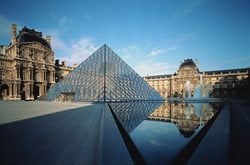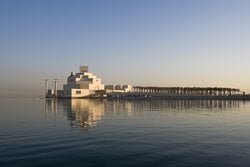
M+, Asia’s global museum of contemporary visual culture in the West Kowloon Cultural District in Hong Kong, presents I. M. Pei: Life Is Architecture, the first full-scale retrospective of Chinese-born American architect Ieoh Ming Pei (1917–2019), widely known as I. M. Pei, one of the most influential architects of the twentieth and twenty-first centuries.
This Special Exhibition will be held in the museum’s West Gallery and open to the public on Saturday, 29 June 2024. Giovanna Silva, A bride’s photoshoot captured from Passage Richelieu, Grand Louvre (1983–1993), Paris, 2021. Commissioned by M+, 2021 © Giovanna Silva
Giovanna Silva, A bride’s photoshoot captured from Passage Richelieu, Grand Louvre (1983–1993), Paris, 2021. Commissioned by M+, 2021 © Giovanna Silva
Pei’s high-profile projects were realized over seven decades with an exceptionally wide geographic reach—including the National Gallery of Art East Building in Washington, D.C., the Grand Louvre Modernization in Paris, the Bank of China Tower in Hong Kong, and the MIA | Museum of Islamic Art in Doha.
 Paul Stevenson Oles (illustrator). I. M. Pei & Partners, Rendering of the pyramid entrance on Cour Napoléon in the daytime, Grand Louvre (1983–1993), Paris,1984. pencil on paper. Photo: M+, Hong Kong, digitised with permission © Pei Cobb Freed & Partners
Paul Stevenson Oles (illustrator). I. M. Pei & Partners, Rendering of the pyramid entrance on Cour Napoléon in the daytime, Grand Louvre (1983–1993), Paris,1984. pencil on paper. Photo: M+, Hong Kong, digitised with permission © Pei Cobb Freed & Partners
 Mohamed Somji. View of the faceted central structure, Museum of Islamic Art (2000–2008), Doha, 2021. Commissioned by M+, 2021 © Mohamed Somji
Mohamed Somji. View of the faceted central structure, Museum of Islamic Art (2000–2008), Doha, 2021. Commissioned by M+, 2021 © Mohamed Somji
These landmark projects solidified his legacy and position in architectural history and popular culture. His life and work weave together a tapestry of power dynamics, geopolitical complexities, and cultural traditions around the world. His transcultural vision laid a foundation for the contemporary world.
Organized with the support of the Estate of I. M. Pei and Pei Cobb Freed & Partners, which succeeded the architectural firm Pei founded, the exhibition is curated by Shirley Surya, Curator, Design and Architecture, M+, and Aric Chen, General and Artistic Director, The New Institute in Rotterdam. This retrospective features more than three hundred objects, many of them never exhibited before. These include original drawings, architectural models, photographs, films, and other archival documentation from institutional and private holdings. South Ho Siu Nam, View of facade, Bank of China Tower (1982–1989), Hong Kong, 2021. Commissioned by M+, 2021 © South Ho Siu Nam
South Ho Siu Nam, View of facade, Bank of China Tower (1982–1989), Hong Kong, 2021. Commissioned by M+, 2021 © South Ho Siu Nam
The exhibition takes a close look at Pei’s life and work through six areas of focus that not only define his unique practice, but also place his architectural projects in dialogue with social, cultural, and biographical trajectories, showing architecture and life to be inseparable. These areas are:
• Pei’s Cross-Cultural Foundations shows how Pei’s upbringing and architectural education formed the foundation of his ability to reconcile multiple sources of influence across cultures and between tradition and modernity.
• Real Estate and Urban Redevelopment unveils a lesser-known phase of Pei’s career as part of real estate developer Webb & Knapp in New York City. It explores his contributions to mixed-use planning, housing, and urban revitalisation projects in the United States in the 1960s, and subsequently beyond American borders.
• Art and Civic Form introduces Pei’s museum designs and his frequent collaborations with artists from Henry Moore to Zao Wou-Ki. The section demonstrates his belief in museums as civic spaces, the importance of dialogue between art and architecture, and his deep affinity with the contemporary art of his time.
• Power, Politics, and Patronage reveals how Pei—with his technical mastery, ingenious problem- solving, and sensitivity to client needs—became a trusted collaborator in high-profile commissions that drew both immense support and public controversy throughout his career.
• Material and Structural Innovation illustrates Pei and his team’s consistent inventiveness in the use of materials and construction methods, especially with concrete, stone, glass, and steel.
• Reinterpreting History through Design examines Pei’s long-standing interest in making modern architecture relevant to different histories, traditions, and ways of life, particularly those related to his birthplace. Pei distilled the essence of cultural and historical archetypes to provide formal or spatial strategies for contemporary needs. Helmut Jacoby (illustrator). I. M. Pei & Associates, Rendering of museum and public plaza, Everson Museum of Art (1961–1968), Syracuse, New York. ca.1961, ink on paper. Photo: M+, Hong Kong, photographed with permission © Pei Cobb Freed & Partners
Helmut Jacoby (illustrator). I. M. Pei & Associates, Rendering of museum and public plaza, Everson Museum of Art (1961–1968), Syracuse, New York. ca.1961, ink on paper. Photo: M+, Hong Kong, photographed with permission © Pei Cobb Freed & Partners
To engage a new generation of architecture students with the work of I. M. Pei, M+ has partnered with two Master’s programmes focusing on the design of tall structures and cultural spaces at the University of Hong Kong Department of Architecture and The Chinese University of Hong Kong School of Architecture respectively. Students have contributed to creating altogether five models in their studios to represent some of Pei’s most significant built and unbuilt projects. The projects include ‘Museum of Chinese Art for Shanghai’ (1946), Harvard University’s Graduate School of Design Master’s thesis; Hyperboloid (1954–1956; unbuilt), New York; and Luce Memorial Chapel (1954–1963), Tunghai University, Taichung. Liu Heung Shing, I. M. Pei with Jacqueline Kennedy Onassis and guests at Fragrant Hill Hotel’s opening, 1982. Photo: © Liu Heung Shing
Liu Heung Shing, I. M. Pei with Jacqueline Kennedy Onassis and guests at Fragrant Hill Hotel’s opening, 1982. Photo: © Liu Heung Shing
The exhibition also features newly commissioned photographs of eleven of Pei’s built projects by seven international photographers, taken during the pandemic, to reconsider the enduring influence of Pei’s work. The photographers are South Ho Siu Nam (Hong Kong), Naho Kubota (New York City), Lee Kuo- Min (Taipei), Giovanna Silva (Milan), Mohamed Somji (Dubai), Tian Fangfang (Shanghai), and Tomoko Yoneda (Tokyo/London).
Suhanya Raffel, Museum Director, M+, says, ‘Few lives embody the vision of transcultural exchange at the heart of M+ as thoroughly and elegantly as that of I. M. Pei. We are honoured to host the first major retrospective devoted to the legendary architect, whose work shaped the built environment for the twentieth and twenty-first centuries. This project reintroduces Pei and his contributions to a contemporary audience worldwide while bringing to the surface important facets of his career that have long been overlooked.’ I. M. Pei outside John F. Kennedy Presidential Library and Museum, Dorchester, Massachusetts, 1979 © Ted Dully/The Boston Globe via Getty Images
I. M. Pei outside John F. Kennedy Presidential Library and Museum, Dorchester, Massachusetts, 1979 © Ted Dully/The Boston Globe via Getty Images
M. Pei’s son, the architect Li Chung (Sandi) Pei, partner and founder of PEI Architects, says, ‘This exhibition brings to the public the first major retrospective of our father’s productive and far-reaching career, notably elucidating the transcultural influences and distinctive historical circumstances that contributed to his unique place as an architect and global citizen. Gathered over many years from a multitude of sources, the exhibition details a remarkable personal story that only in its full telling reveals the complexities, challenges, and achievements of his long and optimistic life. We are proud of this exhibition and thank the M+ team for its thorough, intelligent, and enlightened documentation.’
To coincide with the exhibition, a new 400-page book I. M. Pei: Life Is Architecture with 469 colour illustrations will be published in July 2024 by Thames & Hudson in collaboration with M+. The title presents both celebrated and lesser-known aspects of Pei’s life and career by featuring largely unpublished archival materials, newly commissioned photographs and essays, as well as personal anecdotes from scholars and those who knew and worked with Pei.
Image courtesy of Thames & Hudson
M. Pei: Life Is Architecture is generously supported by the Lead Sponsor Bank of China (Hong Kong), Bei Shan Tang Foundation, the Family of S. P. Tao, Travel Partner Cathay, and Hotel Partner The Ritz-Carlton, Hong Kong.
***
Press release and photos courtesy of West Kowloon Cultural District Authority
Cover photo: Portrait of I. M. Pei taken when he was selected to design the John F. Kennedy Presidential Library and Museum, Dorchester, Massachusetts,1965. © John Loengard/The LIFE Picture Collection/Shutterstock



 22
22
 28
28
comment